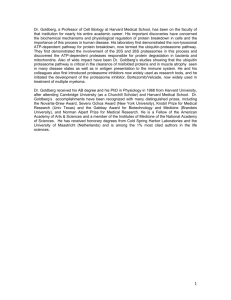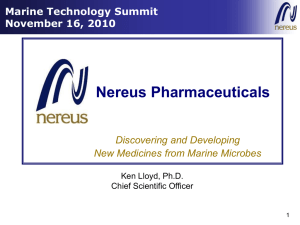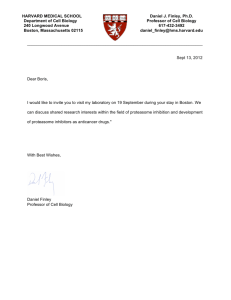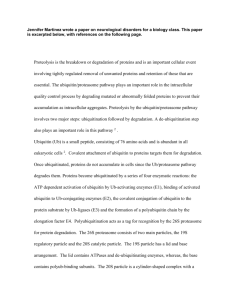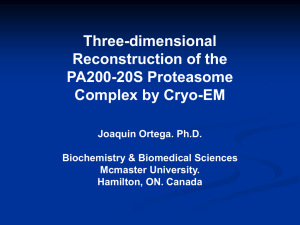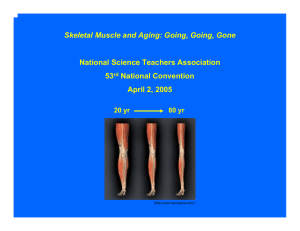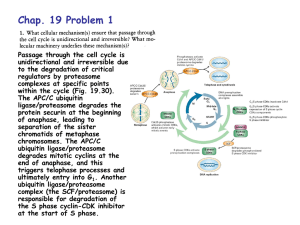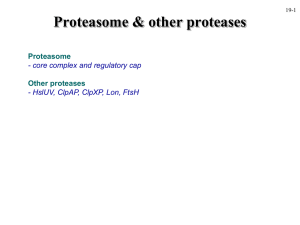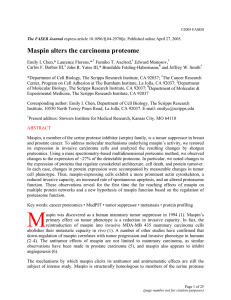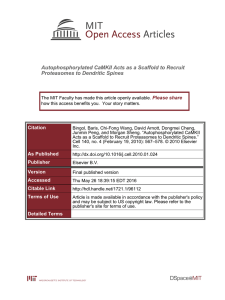Mini-Symposium September 8, 2003 Muscles & Aging: Going, Going, Gone
advertisement
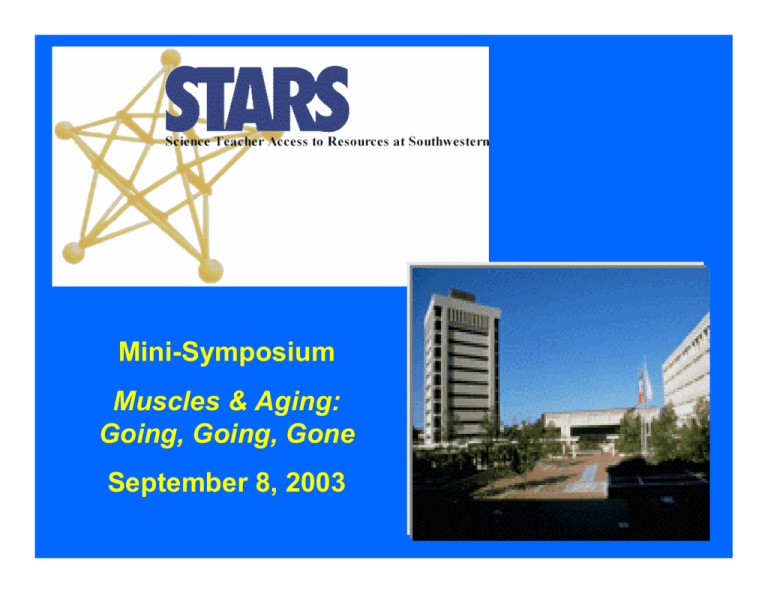
Mini-Symposium Muscles & Aging: Going, Going, Gone September 8, 2003 DNA Transcription mRNA Translation Protein DNA RNA Processing Transcription mRNA Degradation RNA Stability Protein Processing, Transport, Stability Translation Protein Degradation DNA Transcription mRNA Translation DNA Protein RNA Processing Transcription mRNA Degradation RNA Stability Protein Processing, Transport, Stability Translation Protein Degradation Protein Turnover Synthesis vs Degradation Steady State Synthesis = Degradation Pathways of Intracellular Protein Degradation • Lysosomal Mechanisms (Cathepsins) • The Calpain System • Mitochondrial Proteases • The Ubiquitin-Proteasome Pathway Lysosomal Mechanisms • Lysosomes digest “food” macromolecules into smaller subunits. • The lysosome has hydrolytic enzymes to break down polymers into monomers. • Subunits such as monosaccharides and amino acids are pumped across the lysosomal membrane into the cytoplasm. • The lysosome is maintained at an acid pH to denature macromolecules, aiding hydrolysis. The Calpain System • Calcium-dependent neutral proteases • Chimeras of a papain-like protease and a calmodulin-like calcium-binding protein • Muscle-specific form is gene product responsible for limb girdle muscular dystrophy • May degrade selected proteins during calcium-mediated signal transduction pathways Pathways of Intracellular Protein Degradation • Lysosomal Mechanisms (Cathepsins) • The Calpain System • Mitochondrial Proteases • The Ubiquitin-Proteasome Pathway The ubiquitin-proteasome pathway of intracellular protein degradation Modification of proteins with ubiquitin E3(n) = O -C-OH E1 E2(n) E1 E2(n) E2(n) ATP Ubiquitin Degradation of ubiquitinated proteins ATP Proteasome Regulatory Proteins (PA700) ATP 26S Proteasome GND129 Topology of the proteasome’s catalytic sites α β β α o 13 A The proteasome’s multiple catalytic sites are located on β subunits and face the interior channel GND130 Proteolysis by the 26S proteasome 7) ubiquitin isopeptidase 1) activation by gating 2) polyubiquitin chain binding 6) peptide bond hydrolysis 3) ATP hydrolysis 4) substrate unfolding 5) translocation of unfolded polypeptide chain GND133c Electron microscopy of proteasomePA700 complexes o 100 A Proteasome Proteasome -PA700 GND103 Conditions Leading to Muscle Wasting (Atrophy) • • • • • • • • • Limb immobilization (casting) Microgravity Prolonged bed rest/hindlimb suspension Tumor bearing Fasting/malnutrition Burns Infection Denervation Sarcopenia Sarcopenia Sarcopenia is age-related loss of lean muscle mass Loss of ~40% of muscle mass by 80 years of age Loss of locomotion due to atrophy of type IIb fibers Loss of capacity to withstand injuries and diseases (http://www.sarcopenia.com/) Sarcopenia and Ubiquitin-Proteasome Pathway - Proteasome degrades >80% of cellular proteins - Proteasome is the major player in a variety of atrophies - Myofibrillar proteins are proteasome substrates - Proteasome degrades oxidized, damaged, & denatured proteins Change in Lean Muscle Mass with Age Muscle Mass to Body Mass Ratio (F344BN rats) Muscle Mass to Body Mass Ratio (Sprague-Dawley rats) 0.5 0.35 0.45 0.4 0.25 Lateral Gastrocnemius 0.2 Medial Gastrocnemius 0.15 0.1 % of body weight % of body weight 0.3 0.35 Lateral Gastrocnemius 0.3 Medial Gastrocnemius 0.25 0.2 0.15 0.1 0.05 0.05 0 0 3 mo. 13 mo. 27 mo. 30 mo. 4 mo. age (m onths) 12 mo. 32 mo. age (m onths) Heart Mass to Body Mass Ratio (Sprague-Dawley rats) 0.5 0.45 % of body mass 0.4 Muscle mass (g) 0.35 0.3 X 100 = % Body mass Heart 0.25 Body mass (g) 0.2 0.15 0.1 0.05 0 3 mo. 13 mo. 27 mo. age (m onths) 30 mo. Proteasome Activity Proteasome Activity in Muscle (Sprague-Dawley rats) 80 70 FU/mg 60 ChT -L 50 T -L 40 30 PGPH 20 10 0 3 mo. 13 mo. 27 mo. 30 mo. age (months) Proteasome Activity in Heart (Sprague-Daw ley Rats) 80 70 FU/mg 60 50 ChT -L 40 T -L 30 P GP H 20 10 0 3 mo. 13 mo. 27 mo. age (months) 30 mo. Sarcopenia at the Cellular Level (Sprague-Dawley Rats) 30 month ATPase (metachromatic stain) S4 13 month 3 month Exercise • • • • Endurance Exercises Strength Exercises Balance Exercises Stretching Exercises National Institute on Aging www.nia.nih.gov/exercisebook American College of Sports Medicine www.acsm.org 220k 97.4k 66.0k 46.0k 30.0k 21.5k 14.3k C 1d 3d 7d 10d 14d 21d 28d Duration of Stimulation Duration of Stimulation + Proteasome PA700 (p31) PA28 Control 1d 3d 7d 14 d 21 d 28 d Effect of contractile activity on 14C casein degradation - Ub/ATP + Ub/ATP + Ub/ATP/Lac Control 3.1 7.2 2.9 Stimulated 6.7 13.8 5.0
